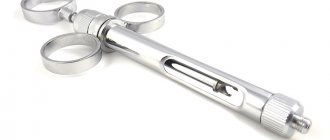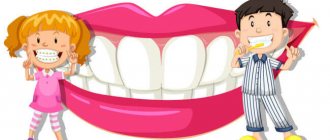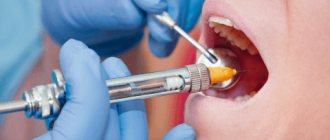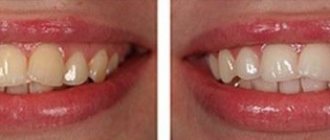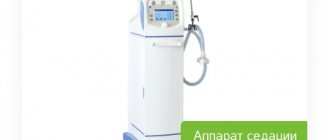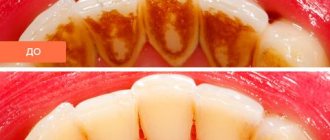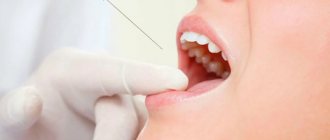Stages of sedation Types When treating children Possible complications Indications Preparation for the procedure Contraindications Anesthesia Alternatives
There are few people in the world who are not afraid of a visit to the dentist. Against the backdrop of such a widespread phobia, calls are increasingly being made to undergo treatment under sedation, without pain. What is it and is this method as safe as they say?
Dental treatment under anesthesia in adults is carried out in rare cases, more often in hospitals. But sedation is more common. This method causes inhibition of the nervous system to reduce panic and stress during the procedure. There is contact with the doctor, the patient is able to respond to stimuli. With this method of anesthesia, the patient breathes on his own, all his reflexes are preserved. This is the main difference between sedation and anesthesia, in which the degree of inhibition reaches such a level that consciousness turns off, reflexes are not preserved, and the patient does not respond to physical and verbal stimuli. The main purpose of anesthesia is to put the patient into a state in which he does not feel anything.
The main goal of sedation is not to harm the patient’s health, so before the procedure it is necessary to do a full examination of the body and obtain a conclusion from a general practitioner and anesthesiologist.
Sedation will help:
- relax during an unpleasant or painful procedure;
- perform local anesthesia without tension and fear;
- provide comfort, moral and physical;
- create a calm environment for the dentist to work.
Anesthesia in dentistry and its difference from sedation
General anesthesia is an alternative to local anesthesia. It involves completely shutting down a person's consciousness to cause loss of sensitivity during treatment. Dental treatment under anesthesia in adults is usually carried out in cases where it is impossible to use other types of anesthesia. Sometimes they resort to using sedation.
Sedation is often confused with anesthesia, but in fact it is an intermediate link between general anesthesia and dental treatment with anesthesia. In this case, the person is in a state of half-asleep, on the border of sleep and consciousness, while at the same time the contact between the patient and the doctor is maintained.
The similarity between sedation and anesthesia is that they are carried out by an anesthesiologist using the same drugs, but the consequences of sedation are milder, since the dosage is much less.
When general anesthesia is administered, the patient falls into deep sleep. He is unconscious. Dental treatment under anesthesia is rarely practiced, since the number of contraindications and risks of complications in this case exceeds the number of prerequisites for it. If possible, it is better to avoid it, as it has a toxic effect on the human body, especially on the heart, cardiovascular and nervous system. Local anesthesia copes with pain relief no worse, most importantly, without serious consequences.
Concept of general anesthesia
General anesthesia also involves the professional actions of an anesthesiologist aimed at artificially introducing the patient into a state of deep sleep with the help of potent drugs used only in anesthesiology. At the same time, the activity of the central nervous system is reduced as much as possible, which is accompanied by a complete absence of pain, any reaction to irritating factors and partial elimination of reflexes. It could be a narcotic drug.
No matter how sad it may sound, at present, general anesthesia with mandatory hospitalization is now mainly carried out only in public clinics, motivated to retain the patient for several days to simulate statistics with a huge hospital load on “bed-days” and the formation of a bonus fund doctors, as these are the rules now.
However, time does not stand still and now a modern operating room in a specialized non-state dental clinic, which involves the use of general anesthesia in its work, is always provided with the following medical attributes:
- artificial lung ventilation device;
- availability of centralized oxygen supply;
- laryngoscopes, blades of various sizes and endotracheal tubes of all sizes;
- monitors for continuous monitoring of all vital signs, that is, blood pressure, heart rate and blood oxygen saturation (saturation);
- subclavian catheters and related accessories;
- defibrillator and never need it again;
- drugs to provide emergency assistance in the event of any acute situations, which is more likely during general anesthesia (adrenaline, atropine, refortan, stabizol, dopamine, mezaton);
- medical equipment that ensures comfortable work for the anesthesiologist (manipulation table, fluorescent lamp, infusion pump, disposable consumables, intravenous catheters, disposable systems in sufficient quantities).
Indications for treatment under anesthesia
- Dentophobia/stomatophobia (panic fear of dentistry in both children and adults);
- Very low pain threshold;
- Strongly expressed gag reflex;
- Individual intolerance to drugs included in local anesthesia, allergic reactions;
- Mental abnormalities that exclude the possibility of contact between the doctor and the patient, when the patient is unable to adequately respond to the doctor’s actions;
- A large amount of work, or a very long treatment time;
The composition of some modern local anesthetics:
- lidocaine (xylocaine) in carpules - contains lidocaine, methylparaben, sodium chloride;
- xylostesin F-forte in carpules – contains lidocaine, norepinephrine hydrochloride, anhydrous carbonic sulfite, carbonic chloride;
- xylocaine MPF – sterile pyrogen-free solution without methylparaben (in carpules);
- xylocaine in vials - contains methylparaben;
- xylocaine MPF with epinephrine - sterile pyrogen-free solution contains xylocaine, epinephrine, sodium metabisulfite, citric acid;
- mepivacaine (mepidont, mevirin, mepivastezin, scan-dicaine, scandonest) – without the addition of vasoconstrictors, sulfites, parabens;
- ultracaine in carpules – contains articaine, adrenaline (0.006), sodium disulfite, methylparaben;
- ultracaine Dc forte – contains articaine, adrenaline (0.012) and sodium disulfite;
- septanest – contains sulfites, EDTA, does not include parabens;
- ubistezin, ubistezin forte (based on articaine, do not contain parabens, but contain sulfites as a preservative).
How is treatment performed under general anesthesia and its types?
To be able to carry out treatment under general anesthesia and guarantee the safety of patients, a dental clinic must have a number of characteristics, namely:
- Have a license for anesthesiology and resuscitation, as well as the right to use potent drugs;
- Have a staff of anesthesiologists and resuscitators, have all the necessary equipment and equipment;
- Set up a temporary room for the patient until the general anesthesia wears off.
Contraindications to sedation
Like any medical procedure, depression of consciousness has contraindications. There are very few of them. The only absolute contraindication is myasthenia gravis (muscle weakness). The remaining states are relative. These are drug or alcohol intoxication, hypotension, a full stomach, a disorder of consciousness that prevents interaction with the patient, pregnancy, a condition after an acute heart attack/stroke. An opinion on the possibility of carrying out this procedure can only be issued by a general practitioner and an anesthesiologist.
The choice of method may also be limited. Thus, inhalation methods are contraindicated for sinusitis and other diseases of the upper respiratory tract. The doctor must know about all diseases in order to select the appropriate drug for a particular one in order to use medicinal sleep in dental treatment without consequences. That is why it is important to treat teeth in a clinic with modern technical facilities. Typically, such dentists employ experienced anesthesiologists and have equipment for first aid.
Expert opinion
Emir Romanovich Omerelli
Maxillofacial surgeon, implantologist
Experience: more than 13 years
To exclude the development of complications, before starting treatment it is necessary to conduct a thorough examination: ECG, X-ray of the lungs, consultations, if necessary, with a therapist, cardiologist and other doctors, collection of blood tests. All this is important to fully assess the patient’s condition and select the optimal type and drug of anesthesia.
They are as follows:
- Mask (inhalation), which is carried out by the patient inhaling a mixture of oxygen and anesthetic gases through a mask. This type of anesthesia is often given to children;
- Intravenous. By introducing anesthetic drugs into the blood.
Dental procedures that can be performed under general anesthesia:
- Removal of a tooth cyst;
- Removal of several wisdom teeth;
- Multiple dental implants.
Possible complications during general anesthesia
There are many side effects of general anesthesia. Sometimes, even in the absence of contraindications, the body's reaction to an anesthetic can be unpredictable, so anesthesia is always a risk. The following complications may occur:
- Decreased cognitive function of the brain;
- Difficult recovery from anesthesia, prolonged confusion;
- Dizziness;
- Nausea and urge to vomit;
- Strong headache;
- Muscle pain;
- Injury to the oral cavity (tongue, teeth, lips);
- Respiratory tract infection;
- Severe brain damage, death (the percentage of cases is minimal).
Types of anesthesia for painless dental treatment
Depending on the complexity of the upcoming dental intervention, the doctor can offer the client three options for pain relief:
Application. The anesthetic drug is applied to a gauze pad and applied to the area of the upcoming dental intervention. This method is not able to eliminate severe pain, therefore it is relevant only when helping children, for example, when removing milk units before injecting the medicine.- Infiltration. It is a full-fledged injection, but the medicine is not injected very deeply. The medicine “turns off” peripheral nerve endings. This is enough to painlessly eliminate caries (including deep caries), pulpitis and other diseases.
- Conductor. This type of anesthesia affects both small nerve branches and large clusters, trunks and canals of nerves. Having given an injection, the doctor immediately makes half of the jaw insensitive. This allows you to painlessly perform complex surgical operations, removal, and treat inflammatory pathologies of the oral cavity.
Treatment prices
Dental procedures performed under anesthesia are quite expensive. It consists of a consultation with an anesthesiologist, the qualifications of all doctors involved in the process, the type of anesthesia, the drug administered, the prestige of the clinic and is calculated in proportion to the treatment time. In Moscow, treatment under anesthesia will cost from 15,000 rubles per hour. In the regions of Russia the price is lower, ranging from 10,000 rubles per 1 hour.
It is very important to inform patients about all the nuances of treatment using general anesthesia, so that the person can assess the risks and decide whether to undergo treatment under anesthesia or choose safe local anesthesia. Treatment and removal of teeth under anesthesia can really be effective, the main thing is not to forget about the restrictions and contraindications. No dentist can guarantee the absolute success and successful outcome of this method. In addition, careful preparation of the patient for general anesthesia, exclusion of contraindications, and strict adherence to the doctor’s prescriptions are absolutely necessary.
Advantages
Of course, the main advantage of general anesthesia is the complete absence of any patient movements, which lengthen the operation and complicate the doctor’s actions. In addition to this fact, there are a number of other advantages of dental treatment in a completely unconscious position, that is, the following:
- relevant for super-traumatic procedures, the patient does not feel compression, vibrations or other tactile stimuli at all;
- absence of any pain after the procedure, which is due to the long residual presence of the drug in the blood;
- minimizing the risk of postoperative complications, since the doctor is not distracted by the patient’s reaction, which can be quite different if anesthesia or at least sedation is not used;
- decreased saliva production, which is ensured by special medications;
Despite all the advantages of general anesthesia, its use is indicated only in certain cases, in contrast to sedation, which is used at the request of the patient in the dental office, even when the procedure is minimally invasive.
Important! When performing sedation (not anesthesia), the anesthesiologist always ensures maximum psycho-emotional comfort, since he excludes specific micro-irritants from the child’s memory: white coats, smells of the dental operating room, noise effects, medical sounds and visual stimuli;
Under sedation, it is possible to perform any full-scale operation to restore the dentition (bone grafting, ENT surgery, implantation using sinus lift surgery, prosthetics).
